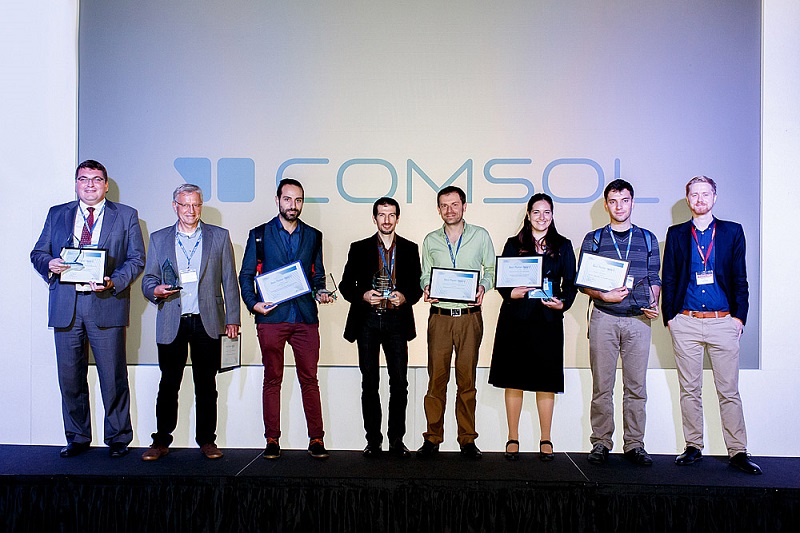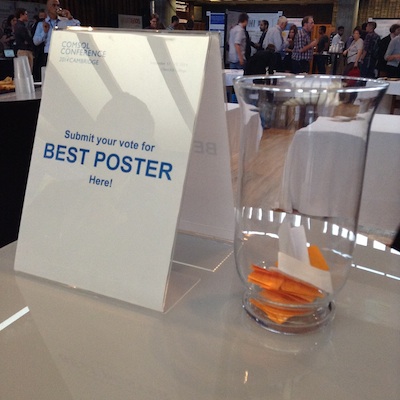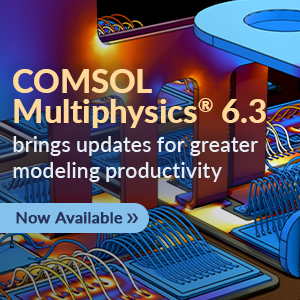
After three busy days of user presentation sessions, minicourses, and poster sessions, the COMSOL Conference 2014 Cambridge came to a triumphant end on Friday. I think I can speak on behalf of all the attendees and say that this was a great event, giving COMSOL Multiphysics users from across Europe (and the world) a platform to exchange ideas, network, and, of course, socialize. Now, I’d like to congratulate the Best Paper and Poster award winners once more.
COMSOL Conference 2014 Cambridge Paper and Poster Awards
The quality of submissions for the COMSOL Conference is very high each year, and this year was no exception. However, three posters and three papers of particularly high quality were singled out to be awarded the Best Poster and Best Paper awards for the COMSOL Conference 2014 Cambridge. The first five award winners were chosen by the conference program committee. The conference attendees voted for the final award for Best Poster. I was delighted to announce the winners and hand out the awards.

COMSOL Conference 2014 Cambridge Best Paper and Best Poster winners. From left to right: Radoslaw Jez, Bernd Baumann, Carmelo Galante, Mattia Cobianchi, Martial Rousseau, Eszter Tóth, Karolis Misiunas. Far right: Robbie Balcombe, COMSOL, Ltd.
Best Paper Winners
DC/DC Multiplanar Transformer Prototype
The first award for Best Paper went to Magdalena Puskarczyk and Radoslaw Jez from ABB Corporate Research Center, Krakow, Poland, for their paper entitled “The Design of a Multilayer Planar Transformer for a DC/DC Converter with a Resonant Inverter”.
The paper presented a rigorous study of a DC/DC multiplanar transformer prototype, including both COMSOL Multiphysics simulation and experimental results. Agreement with experiment validated the simulation. Suitable approximations of the geometry were taken and justified.
The paper illustrates the ability of COMSOL Multiphysics to couple a lumped electrical circuit model with a 3D component model (by combining the Electrical Circuit interface with the Magnetic Fields interface). As DC/DC converters are becoming more “in demand”, this paper combines sound science with an important application.
Sound Radiation by Loudspeaker Cabinets
The second award was given to Mattia Cobianchi and Martial Rousseau from Bowers & Wilkins, Steyning, UK, for their paper “Modelling the Sound Radiation by Loudspeaker Cabinets”.
The authors presented a full study of a loudspeaker cabinet, again including both COMSOL Multiphysics simulation and experimental results. An acoustic-structure interaction approach was adopted, where material properties and damping coefficients were thoroughly investigated, right down to the viscoelastic behavior of the glue. This was approximated using the Thin Elastic Layer condition in COMSOL Multiphysics, an approximation that was tested and justified by a complete model explicitly resolving this layer.
Simulation and experimental results agree quantitatively, except for an offset in the frequency spectrum — an effect that is explained and accounted for in the paper. Overall, the committee found this to be a well-presented and thorough study of an application that all COMSOL Multiphysics users can relate to. This paper also demonstrated an interesting review of the existing literature to outline the novelty of the work.
Acoustic Streaming in High-Intensity Discharge Lamps
The third and final Best Paper award was presented to Bernd Baumann, Jörg Schwieger, and Marcus Wolff from the Hamburg University of Applied Science, Germany, Freddy Manders from Philips Lighting, Belgium, and Jos Suijker from Technical University Eindhoven, Netherlands, for their paper “3D Acoustic Streaming in High-Intensity Discharge Lamps”.
They presented a hypothesis, corroborated by COMSOL Multiphysics simulation, to explain the low-frequency flicker that is observed in high-intensity discharge lamps (HIDs) while the lamps are operating in the optimal frequency range. A truly multiphysics simulation, this study combines electric current, single-phase fluid flow, heat transfer, and pressure acoustics, all strongly coupled in the arc tube of a discharge lamp.
Although the study does not seek to compare the simulation results with experimental results, the results from the simulation agree with observed behavior and are consistent with theoretical expectations. As HIDs account for a considerable fraction of available artificial light sources, as well as making up an increasing market share of the light-emitting diode market, better understanding their behavior and optimizing their performance could have a significant impact on the electric power consumed by lighting — currently 19% of electrical power consumed worldwide.
Best Poster Winners
Mechanically Ventilated Double-Skin Facades
The first Best Poster award was given to Carmelo Galante from Newtecnic, London, UK, for the poster titled “Investigating the Performance of Mechanically Ventilated Double-Skin Facades with Solar Control Devices in the Main Cavity”.
The poster presents an interesting building design study of ventilated building facades. These facades are investigated because of their potential to reduce heating and cooling demands, thus improving building performance by increasing energy efficiency. The study involved combining single-phase fluid flow with the three mechanisms of heat transfer: conduction, convection, and radiation. Radiation was included between surfaces in the model as well as from an external source — the sun. The committee felt the content of the poster was aesthetically pleasing, well-presented, and technically meticulous.
Optimization of a Herringbone Micromixer
The second award was presented to Eszter Tóth and Kristóf Iván from Pázmány Péter Catholic University, Budapest, Hungary, and Péter Fürjes from the Hungarian Academy of Sciences, Budapest, Hungary, for their poster entitled “Optimization of the Herringbone Type Micromixer Using Numerical Modelling and Validation by Measurements”.
Like many of the award winners, credit is given for the completeness of the study and its direct applicability to a practical application. In this case, the application is lab-on-chip devices. The work presents both COMSOL Multiphysics simulation and experimental work on the mixing efficiency of herringbone mixers. These are used to mix chemical analytes with reagents or buffer solutions in sample preparation for lab-on-a-chip devices. The simulation incorporated single-phase flow, mass transport by diffusion and convection, and particle tracing (as a visual aid). The simulation and experimental results show good quantitative agreement and suggest the optimal design for the herringbone geometry.

Best Poster voting in progress at the COMSOL Conference 2014 Cambridge.
People’s Choice: DNA Interactions in Nanopores
The final award was selected by voting among the conference attendees as a “People’s Choice Award”. This was given to Karolis Misiunas et al. from the University of Cambridge, UK, and Sandip Ghosal from Northwestern University, Evanston, USA, for their poster “DNA Interactions in Crowded Nanopores”. This poster presented a study into the force on DNA molecules in an electric field as they enter a nanopore. There was a clear take-home message: this effect is a combination of electrostatics and drag from fluid flow. In nanopores, multiple DNA molecules can interact via electro-osmotic flow — a coupled electrical-CFD effect that requires multiphysics simulation.
Congratulations to all the Winners
The award winners showcase a mixture of applications and scientific disciplines that underline the strength and broad appeal of COMSOL Multiphysics, particularly for modeling multidisciplinary, multiphysics applications. It is also nice to see so many studies, including those receiving awards, with a foothold in real industrial applications or novel academic research.
We have only highlighted six projects here, but there are many others well worth a read, so look out for the user presentations as we add them to our website.
Congratulations to all of you who won Best Paper or Best Poster at the COMSOL Conference 2014 Cambridge!



Comments (0)